DTSC claimed in the white paper that the US EPA’s $41.5 million study of Area IV’s soil for radiation and chemical contamination in 2012 actually showed that toxic smoke from SSFL never went offsite, and thus not down into Brandeis-Bardin. The landmark EPA study determined background numbers for radionuclides and chemicals in Area IV’s dirt as well as map out the massive toxic contamination areas. It had nothing to do with ‘which way the smoke was blowing’ studies so DTSC fabricated that claim with no basis whatsoever. Further, a 2006 study conducted by UCLA’s Professor Yoram Cohen, along with photographs and testimony from former workers, reveal that airborne contamination not only went offsite, it could have traveled for miles.
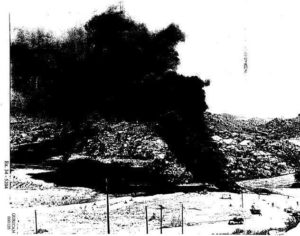
The Area IV employees who set the sodium burn pit alight with gun shots were not stupid people. They located the pit next to the lab’s border with the camp as far removed from the main area of Area IV as possible. They naturally waited for the winds to carry the poisonous smoke offsite before setting a blaze.
An EnviroReporter.com-acquired photograph showing a FSDF burn with Brandeis-Bardin in the background shows this. The fire truck in the foreground provides scale, revealing that the radioactive plume is hundreds of feet high. No visible or invisible wall exists in the archival image suggesting that the toxic smoke was somehow stopped at the border with Brandeis-Bardin.
Toxic smoke settling over SSFL’s neighbors didn’t just come from the FSDF. Thousands of rocket engine tests took place at SSFL over the decades releasing tons of chemically-contaminated smoke, gases and dust. One such ignition at the Coca test stand complex, pictured above, produced huge amounts of toxic smoke belching into the night sky. Coca lies less than a mile from Brandeis-Bardin.
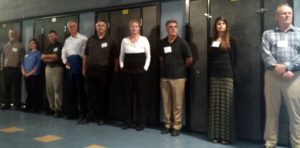
The Santa Susana Field Laboratory is known as SSFL, Rocketdyne or The Hill to former workers, longtime residents and cleanup activists who have fought to remediate the 2,850-acre outdoor lab since the 1980s. Around 30,000 rocket tests spewed toxins over the area along with three partial experimental nuclear reactors melting down in so-called nuclear Area IV of SSFL overlooking BBI. It is the site of the 1959 partial meltdown of the Sodium Reactor Experiment which spewed more radiation into the environment from its unfortified structure than the Three Mile Island partial meltdown did in Pennsylvania in 1979.
The public being in the dark about Rocketdyne is not why DTSC thinks its Brandeis-Bardin white paper will pass the smell test. Perhaps DTSC’s aggressive toxic denial has something to do with BBI owners American Jewish University. NBC4‘s I-Team came out with a blistering report May 15 called Scientists Question State Report on Camp Safety which suggested that DTSC and AJU could be in “collusion” according to one of the I-Team’s whistle blowers. The following transcript of the explosive video segment shows just how far AJU will go to claim there is not contamination from SSFL impacting Brandeis-Bardin:
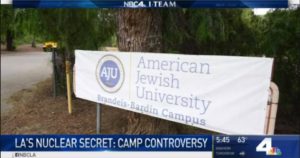
NBC4 screen shot
Strear goes on to attack the facts of the NBC4 reports, saying “we are in a highly compromised position and believe the only repair is through a definitive statement by DTSC substantiating your stated position that our property is safe.” He ends the email by saying, “Timing is most critical. We must produce something in the next 24 hours or we risk significant damage.” [Source: NBC4]
DTSC’s white paper relied in part on a 2017 AJU study of BBI and used it to collaborate its ‘there’s nothing here’ findings. EnviroReporter.com dissected this massive document and found it so revealing that we felt it was necessary to analyze every BBI report AJU has posted online ever since NBC-4’s I-Team began boring down on the camp’s contamination in 2015. The result our 1991-2017 Brandeis-Bardin Reports Analysis.
Almost all of these report summations over the 26 year period are just that, summations, except for the 2017 report which totals 1,372 pages for just eight soil and six water samples. That’s one soil test for every 360 acres and one water test for every 959 acres yet DTSC refers to it as definitive in its white paper.
The 2017 environmental assessment document, as most of the others over the decades, is authored by longtime BBI environmental consultant Joel I. Cehn. Amazingly, Cehn copped to Rocketdyne’s impact on Brandeis-Bardin by noting that the radioisotope tritium was “elevated, due to past releases from SSFL” in the latest report dated March 27, 2017. Fully 20 percent of the scant number of water samples nevertheless tested positive for tritium.
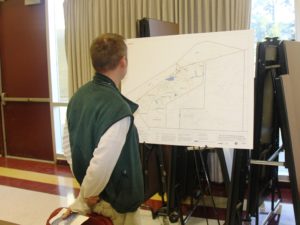
Either AJU hadn’t read Cehn’s report of two days prior or read it and didn’t understand it. And there’s the possibility AJU read the report and understood perfectly well what it said and decided to issue the “Fact Sheet” regardless.
The AJU handout doesn’t jibe with its own 2017 report which documented dioxin sampled at BBI by Cehn that EnviroReporter.com calculated to be a whopping 32 times its BTV. That is if the numbers are to be trusted. Even without a table contents or index, evidence of mishandling of the dioxin samples was noted in the lumbering document. The decision to use the laboratory results went forward with Cehn’s approval.
Not only did AJU know of the tritium, H-3, on its Brandeis-Bardin property, the report summations show that BBI knew that the ongoing release from SSFL of this radioactive “heavy water” was happening since 1995. And it appears to have been spreading. The 2013 summation Cehn prepared for AJU noted “elevated tritium in one of the new wells in the south-central region.”
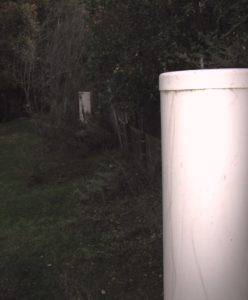
DTSC’s white papering over of Brandeis-Bardin’s toxic troubles does nothing to help clean up the camp. Instead, it perpetuates the toxic denial that has surrounded SSFL for years with claims that contamination somehow magically stays within the lab’s chain link fences.
Future visitors to Brandeis-Bardin can now weigh the facts for themselves. The numbers do not lie even though people charged with keeping the public safe from radiation and rocket fuel residue do.
And the dangers do not end here. DTSC will soon issue a draft environmental impact report for SSFL itself and if the Brandeis-Bardin white paper is any indication, the department will use its super-sized word salad of bad science to sucker the community into accepting a gutted cleanup of one of the most polluted places in California.
READ THE ENVIROREPORTER.COM ANALYSES:
27 Years of Award-Winning SSFL/Rocketdyne Reporting
1998 – 2025
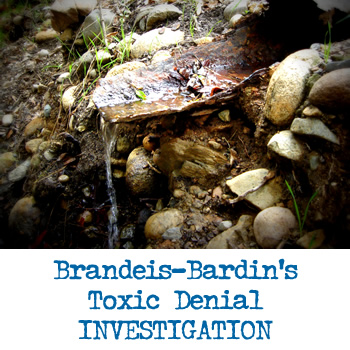












Thank you Michael Collins for this well researched critique of DTSC’s report on contamination at Brandeis-Barden Jewish Children’s Camp. What can I say, other than I am not surprised that your access to the presser was initially blocked, and that none of the questions you posed were answered. Those behaviors would be entirely consistent with previous efforts by DTSC to report dubious conclusions that were not supported by empirical data of past surveys of contamination at SSFL.
At the very heart of this issue lies a more important question. Whose interests, exactly, do State Agencies such as DTSC serve? Is it the companies who own or lease the land at SSFL and Brandeis-Barden? Is it members of the general public who may be near or enter the contaminated areas of those properties? Is it the future generations who will know even less about the history of contamination at these sites when they are converted to park land or real estate development? And what of the public confidence in government after the public realizes that so much damaging information has been swept under the rug by cherry picking results, promoting false conclusions, and generally white washing the truth.
Many will be unable to believe they have lost their health, lost their friends, or their family to the hazardous materials still leaching from SSFL to nearby properties. In the end, the loss of people’s trust in government can be the mortal blow to government itself. Recall that government exists by the informed consent of the governed. Inform us, Michael Collins. Pay attention, everyone else.
Amazing that the State toxics department works SO HARD to deny there’s a problem in Brandeis-Bardin. They test the fewest possible wells — and then excuse dioxins at 32 times acceptable levels, and overall radiation levels of 1,111 TIMES the EPA levels.
It’s mind-boggling and depressing. It’s mind-boggling that anyone thinks Brandeis-Bardin could be remotely safe — a site downstream of 30,000 rocket tests and a meltdown. It’s depressing that the DTSC might get away with this whitewash.
I’m sure glad my kid doesn’t go to this camp — I’d like him to outlive me.